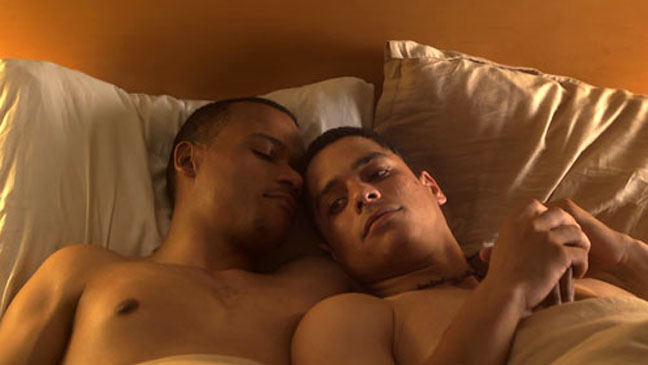By Armond White
“That man is not your maker,“ Robin Thicke teases in the hit song “Blurred Lines.” For a more politically conscious era (as opposed to our politically polarized one), Thicke’s double-entendre would be immediately appreciated for its anti-patriarch joke; instead, it reveals today’s gender confusion for a generation that goes “Huh?” to the idea of patriarchy. That’s the extra-rhythmic fun of “Blurred Lines” as well as the fascination of the new sex comedy The Happy Sad. Like Thicke and his prankster-genius producer Pharrell, The Happy Sad teases the sexual competitiveness of its millennial characters–young adults who hurt each other because they can’t decide which side of the bed they want to sleep on.
 Marcus and Aaron the Black gay couple and Annie and Stan the white straight couple who share beds in The Happy Sad live out a sexual ideology whose political origins and social development they inherited yet blithely ignore. The fact that they’re the generation with options doesn’t mean they traverse carefree terrain; there are sink-holes and pitfalls. Director Rodney Evans uses an emotional Global Positioning System in this adaptation of Ken Urban’s original stage play–emphasis on urban as when Marcus (Leroy McClain) complains to Aaron (Charlie Barnett), “You read my e-mail, then you go screw some NYU boy!”
Marcus and Aaron the Black gay couple and Annie and Stan the white straight couple who share beds in The Happy Sad live out a sexual ideology whose political origins and social development they inherited yet blithely ignore. The fact that they’re the generation with options doesn’t mean they traverse carefree terrain; there are sink-holes and pitfalls. Director Rodney Evans uses an emotional Global Positioning System in this adaptation of Ken Urban’s original stage play–emphasis on urban as when Marcus (Leroy McClain) complains to Aaron (Charlie Barnett), “You read my e-mail, then you go screw some NYU boy!”
The Happy Sad depicts the particularly urban–New York–opportunities for hook-ups and confusion now available to young men and women who use the city to sort out their sexual and sentimental affinities. Not simply another gay love story like Weekend, the recently overrated British film, The Happy Sad crosses Marcus and Aaron with Annie (Sorel Carradine) and Stan (Cameron Scoggins); the two couples collide through bisexuality as another complicated option.
This GPS dance (so delightfully mimicked by Thicke, Pharrell and T.I. in Diane Martel’s Blurred Lines music video, a roundelay of strutting and flouncing, swagger and insouciance) contains the subtle danger and hidden vulnerabilities of the old-fashioned battle-of-the-sexes now equalized into the seduced vs. the seducers. This competition pits intimacy against power, challenge that’s especially felt between genders and races, sometimes coming down to who tops/bottoms who. (Martel’s strictly hetero video splits its male figures into Imp, Player and Pimp.)
What Pet Shop Boys knew about fluid sexual identity in bars, theaters and the romantic imagination of London’s socialites on 1993’s Very (their greatest album?) is repeated in Evans’ mapping of young New Yorkers’ sexual traffic. Evans showed a similar awareness in his 2004 debut Brother to Brother, a rare film about gay life in Harlem (partly a biography of the poet Bruce Nugent just as “Blurred Lines” uses the classic groove of “Got to Give It Up” as Thicke’s salute to the muse of Marvin Gaye’s libido).
In The Happy Sad, Evans observes the world of struggling artists, waiters and indie rock where the classes and races also converge and combust (the world of constant clubbing captured and catered to by Thicke’s big hit). The very daring Annie proposes a new-style relationship to Stan as “We can be different. Try something new. Open things up.” He’s willing but she’s more honest: “It’s like you’re my boyfriend and my gay best friend rolled up into one.” Rewind to the Pets: Very’s opening track asked “Can You Forgive Her?”
Interestingly, the film doesn’t pivot around Stan; even though he is the common link to the quartet he’s no less confused than the others. But as the white male, privileged by cultural hegemony, Stan represents something distinctive in Evans’ worldview. All the actors are attractive but Stan’s singer-songwriter ambitions (and coy swagger?) position him as the patriarchal ideal all the characters must pass through–even the black male couple Marcus and Aaron who mistake the normative with love. In the film’s most subtle development, Annie eventually steers herself away from that ideal toward two ethnically and emotionally different women.
In the urban dance that Evans calls The Happy Sad, deep emotions appear on the surface but are treated superficially by these inconstant characters. We’ve seen this dance in greater art like Max Ophuls’ La Ronde with its elegant juxtaposition of erotic fears and delusions. This is a La Ronde for the post-AIDS era, infected by inconstancy and impatience. (“We’ve got unlimited minutes, now listen!” Marcus demands.) Esthetically, Evans doesn’t achieve Ophuls’ visualization of spatial/spiritual distance as when Marcus and Aaron text each other from adjacent rooms. He could study Antonioni, too.
Still, no recent film that I’ve seen explores personal relations with this kind of acuity–not Mumblecore or Woody Allen either. The value of Evans and Urban’s contribution to New York cinema comes out of their informed attention to urban mixing: how young women and men still cling to the security of race and gender roles of the past. “Everybody get up!” Pharrell encourages throughout Thicke’s multiracial “Blurred Lines” and Evans and Urban would concur as they sort out a sense of civility amidst today’s simple yet complex marriage-equality algebra. Even Pet Shop Boys might approve.
Follow Armond White on Twitter at 3xchair
